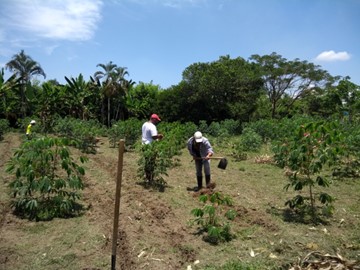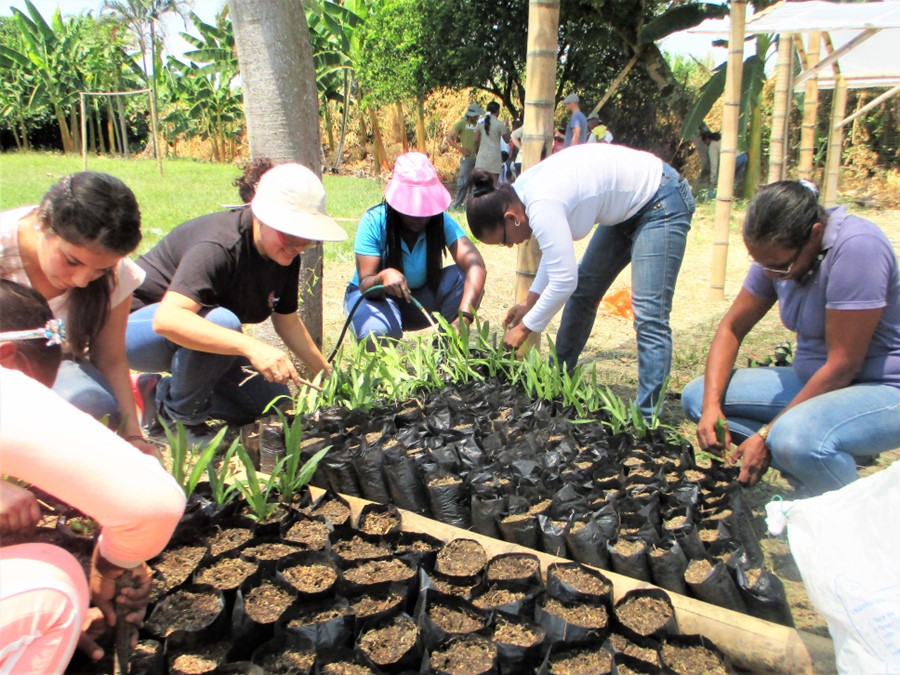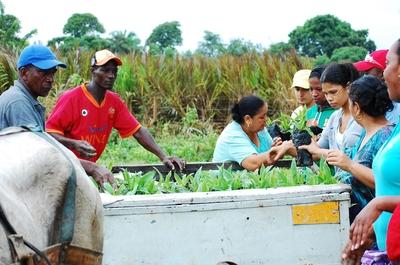
Agroforestry: Revolutionizing Farming, Empowering Farmers, and Protecting the Planet
“The fundamental basis of the community is agriculture, tillage of the soil.”

Nature generously provides us with seeds, nuts, water, fresh air, and the joy of running through forests—a home where we truly feel alive. However, as we cultivate food, protecting and preserving this precious home is vital. Agroforestry is a sustainable agricultural practice that promotes a balance between nature conservation and food cultivation. It offers a resilient and diverse food system that coexists harmoniously with the environment. In this blog post, we will explore the benefits of agroforestry in transforming farming methods, empowering farmers, and protecting the planet.
(All photos in this blog are from initiatives in Colombia and Zambia to which Planting Hope has contributed.)
Agroforestry: The Integration of Farming and Forestry
Agroforestry is an approach that enables agriculture and nature to coexist in harmony. It involves growing trees alongside crops and livestock to enhance productivity, profitability, and biodiversity within the farming system.1 Let's explore the impact of agroforestry from different perspectives:
1. Scope and Diversity:
Agroforestry embraces a more diverse and symbiotic relationship between trees, crops, and animals compared to agriculture. This multifunctional land-use system enriches the ecosystem, providing numerous benefits for farmers and fostering resilience in agricultural practices.
2. Environmental Impact:
Agriculture dedicates large areas to a single crop, resulting in increased pest vulnerability, soil degradation, and reduced biodiversity. In contrast, agroforestry, with its emphasis on diverse species, delivers numerous environmental benefits. These benefits include: 2
Soil conservation: Trees act as natural windbreakers, preventing soil erosion. Their roots bind the soil particles together, protecting it from heavy rains and floods. Fallen leaves and branches also enrich the soil with valuable nutrients, fostering a nourishing environment for plant growth.
Carbon storage: Agroforestry maximizes carbon sequestration by integrating trees into farming systems. Trees absorb CO2 from the atmosphere, storing it in their trunks, branches, and roots, helping to mitigate climate change.
Biodiversity conservation: By incorporating a variety of trees, shrubs, crops, and animals, agroforestry creates diverse habitats. This rich habitat attracts beneficial insects, birds, and other wildlife, fostering a balanced and resilient ecosystem. Agroforestry practices help protect and restore natural habitats, protecting biodiversity and creating a thriving natural environment.
Water management: Trees and shrubs in agroforestry regulate water flow, reducing the risk of flooding. They act as windbreakers, reducing water loss through evaporation and providing shade that helps keep the soil moist. Their roots act as natural channels, allowing water to slowly enter the soil and recharge groundwater. As a result, trees help maintain water availability, prevent runoff and erosion, and promote sustainable water management.
3. Economic Benefits:
While both agriculture and agroforestry offer economic advantages, they differ in terms of stability and profitability. Agriculture, focusing on specific crops or livestock, can be vulnerable to risks and uncertainties, such as unpredictable climate conditions that may lead to lower harvests and reduced income.
In contrast, agroforestry provides farmers with a more stable and diverse range of income streams. In addition to their farming products, they can generate revenue from timber, fruits, nuts, medicinal products, and fodder. 3 By expanding their sources of income, agroforestry offers farmers greater financial security and profitability.
4. Long-Term Sustainability:
Agroforestry is essential for long-term sustainability as it generates environmental, economic, and social benefits.4 Unlike agriculture, it improves farmers' economic resilience, mitigates the environmental impact of climate change and farming practices, and promotes the well-being of present communities and future generations. By integrating trees with agricultural systems, agroforestry provides a multifunctional approach that enhances land-use sustainability. This integration helps protect natural resources, preserve biodiversity, and maintain ecosystem health, ensuring a sustainable and prosperous future for all.

The Main Types of Agroforestry
There are different ways in which farmers can incorporate trees into their farmlands. Here are 5 main types of agroforestry system:
Silvopasture: This system combines forestry and livestock grazing, allowing farmers to optimize land use and promote biodiversity. Trees provide grazing fields for livestock while offering various benefits, such as improved soil health and carbon sequestration.
Silvoarable: In this system, trees and crops are grown together in rows, creating a symbiotic relationship. Trees provide shade, windbreaks, and nutrient cycling, while crops generate income for farmers.
Agrosilvopasture: This integrated approach combines agriculture, forestry, and livestock cultivation in the same field. It maximizes land productivity, enhances biodiversity, and improves soil health, benefiting both farmers and the environment.
Hedgerows or Windbreaks: These are rows of vegetation planted along field boundaries, serving multiple purposes. They provide habitat for wildlife, prevent soil erosion, act as windbreaks, and support pollinators.
Riparian buffer strips: These strips consist of forests or planted vegetation along water bodies. They protect water quality by filtering pollutants, provide habitat for aquatic species, reduce erosion, and aid in water absorption for plant growth. 5

Planting Hope: Empowering Communities through Agroforestry and Urban Gardening Initiatives
Planting Hope, launched by the TwoWings foundation, is a program dedicated to promoting agroforestry practices and urban gardening initiatives. It focuses on empowering individuals to initiate small-scale agroforestry and urban gardening programs. In urban gardening, people plant trees and plants in public spaces, balconies, yards, or small farms. They consume the produce themselves or exchange it locally. The small agroforestry program provides local communities with fruit and non-fruit tree seedlings, benefiting them through food security, income generation, and environmental preservation. By addressing food shortages and creating job opportunities, Planting Hope brings socio-economic and environmental benefits. To learn more about Planting Hope's mission and activities, visit our website's "About Us" and "What We Do" sections.

In Summary
Agroforestry is a transformative approach that combines the best of both worlds. By integrating trees, crops, and livestock, this practice promotes environmental sustainability and economic resilience. It offers a range of benefits, from soil conservation and carbon storage to biodiversity conservation and water management. Through agroforestry, farmers can enjoy their increased productivity while simultaneously working towards a sustainable and prosperous future.
Let's work towards a future where people and nature are in harmony. We can create a world where our food sources are not only nutritious but also sustainable. This vision can be achieved by educating and supporting farmers, collaborating with NGOs, and advocating for government policies that encourage and prioritize sustainable farming practices. By embracing agroforestry, we can revolutionize farming, empower farmers, and protect the planet for generations to come.
Read Our Insightful Blog Posts

Agroforestry: Revolutionizing Farming, Empowering Farmers, and Protecting the Planet
Discover the benefits of agroforestry, a sustainable solution that supports farmers and environmental protection.

The Joy of Giving: Unveiling the Neuroscientific Reasons Behind Charitable Donations
Uncover the neuroscience behind charitable giving and discover how acts of generosity can significantly uplift your mood, enhance social bonds, and contribute to a more fulfilling life.

Nuclear Power Phase-Out in Germany: A Shift Towards Renewable Energy Sources
Join us as we discuss nuclear energy, its advantages and disadvantages, and explore Germany's nuclear power phase-out and its transition towards renewable energies.
Green Your Inbox!
With our Newsletters, Stay updated on our Stories of Change and Growth.
As a gift, get a personalised Nature E-card from PH.

